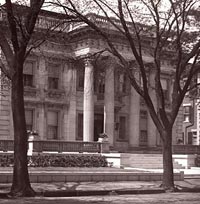Travel through time
 Built for Frederic and Elisabeth Scott by the Richmond architecture firm of Noland
& Baskervill, the Scott House (1907 – 11), at 909 W. Franklin St., is a stellar example of the American Renaissance.
Built for Frederic and Elisabeth Scott by the Richmond architecture firm of Noland
& Baskervill, the Scott House (1907 – 11), at 909 W. Franklin St., is a stellar example of the American Renaissance.
Patterned after the Petit Trianon at Versailles, the mansion reflects the grandeur and prosperity of Richmond’s early-20th century, when it was one of the principal insurance and banking centers of the South.
 1862
1862Frederic William Scott is born. He is raised in Petersburg, Va., and attends Princeton University. Upon returning to Richmond, Scott works at his grandfather’s company, Thomas Branch & Company.
 1893
1893With Charles Stringfellow, Frederic Scott opens Scott & Stringfellow on May 20. Also that year, Scott marries Elisabeth “Elise” Mayo Strother. The couple would have five children.
 1903
1903Elisabeth Scott bought the parcel of land at 909 W. Franklin St. from the estate of Lewis Ginter. The Stable is the first structure to be designed and built on the property.
 1906
1906Frederic Scott contracts the Richmond architecture firm of Noland & Baskervill to design his house.
 1907 – 11
1907 – 11-
In 1907, construction begins at 909 W. Franklin St. The house is completed in 1911.
In December 1911, the Scott family moves into the house.
 1930
1930On Dec. 10, at the age of 62, Elisabeth Scott dies from complications of a brain tumor. She is buried in Richmond's Hollywood Cemetery.
 1939
1939On Sept. 24, at the age of 77, Frederic Scott dies of a heart attack. He is buried in Richmond's Hollywood Cemetery.
 1940
1940-
During World War II, son Fred Scott and his wife Elizabeth Pinkerton Scott, reside at 909 until 1945.
Later, daughter Elisabeth Scott Bocock and her family move into the mansion from 1107 Grove Ave. She would reside at the house until her death in 1985.
 1956
1956In July, Elisabeth Scott Bocock, along with other concerned individuals, founds the Historic Richmond Foundation to help preserve the neighborhood around the notable St. John’s Church in Church Hill.
 1963
1963-
Elisabeth Scott Bocock creates the 2300 Club at 2300 E. Broad St. in Church Hill in order to provide residents with a place to dine, meet or socialize. Currently, the Club is located at 2300 E. Grace St.
ESB founds the Hand Workshop to teach youngsters how to create art, pottery, sculpture and more. Now known as the Visual Arts Center of Richmond, it is a popular organization in the Fan District, offering many classes to children and adults alike.
ESB and husband John Holmes Bocock make the back of 909 an apartment for themselves. Richmond Professional Institute, which later becomes Virginia Commonwealth University, leases the front of 909 for a women’s dormitory.
 1964
1964The third floor of the house is opened to students in the fall. Students continue to rent rooms in the house through the 1990s.
 1969
1969VCU’s first degree-granting year. Because of an absent classmate, Elisabeth Scott Bocock receives the first diploma handed out at the commencement ceremony.
 2002
2002The Richmond Symphony chooses 909 (known then as the Bocock House) for its Designer House held in September and October. Several VCU alumni make over rooms throughout the house.
 2003
2003Partial renovation and design plans begin. VCU contracts interior designer and alumnus Gary Inman (M.A. ’93) to develop a design for the first floor based on the architecture of the building.
 2004
2004-
In May, VCU’s Office of University Advancement moves to the 2nd and 3rd floors of the house.
Phase I of the design plan begins thanks to a $50,000 grant from a private Richmond-based foundation. Repairing woodwork and cabinetry, refinishing the floors, and decorative painting of the walls and ceiling throughout the first floor prepare the house for public use.
In June, the Scott House is deemed a Virginia Historic Landmark.
In the fall, VCU opens the doors of the Scott House to the public. With the Friends of the Library Association, VCU hosts the Scott Family at the house. Mary Buford Hitz, granddaughter of Frederic and Elisabeth Scott, reads from her book “Never Ask Permission,” a memoir of her mother, Elisabeth Scott Bocock.
